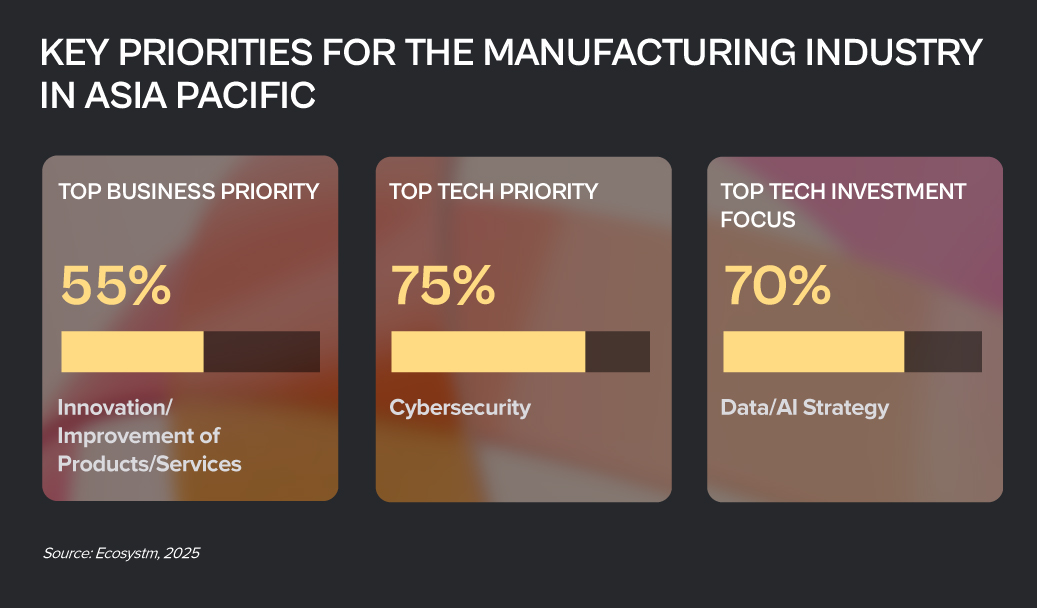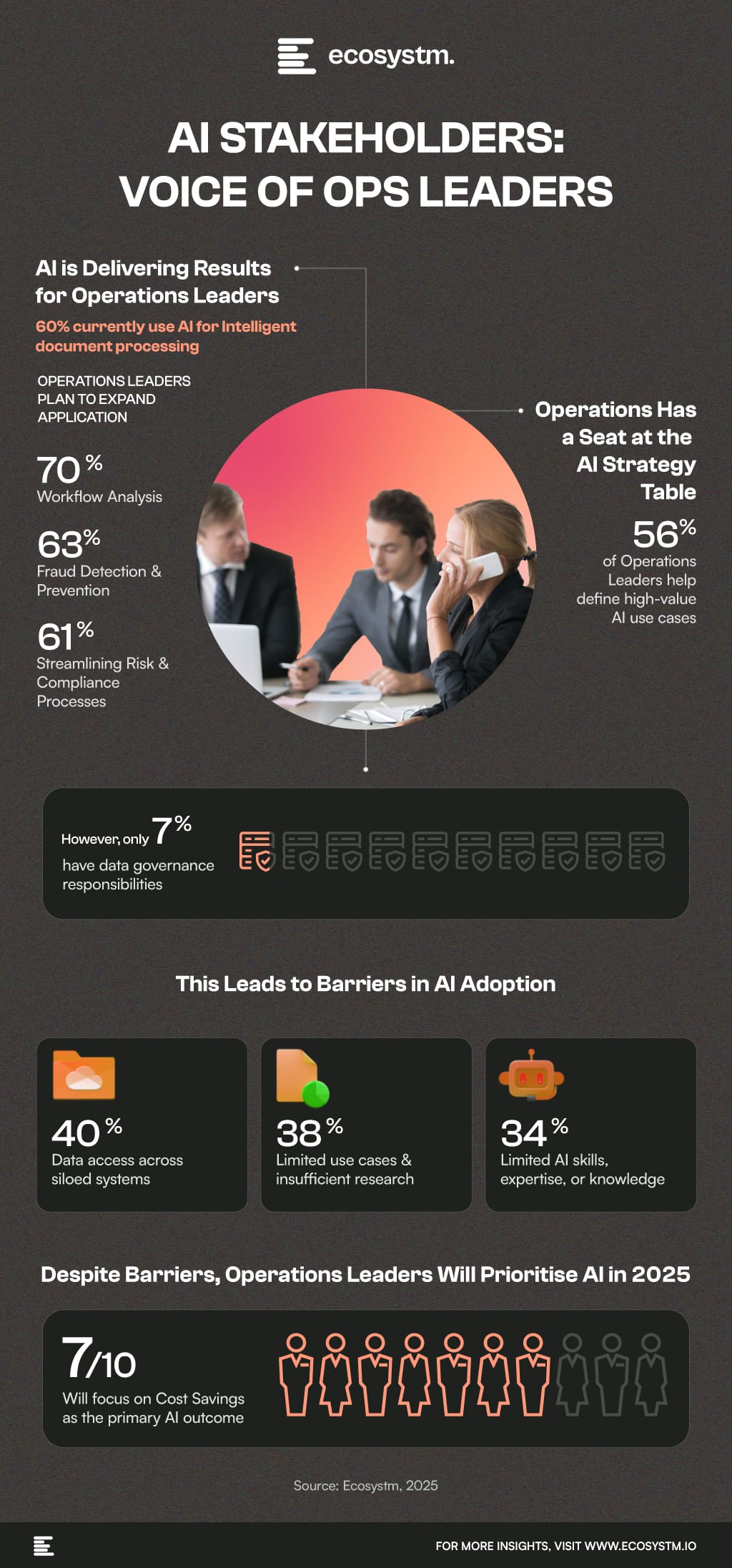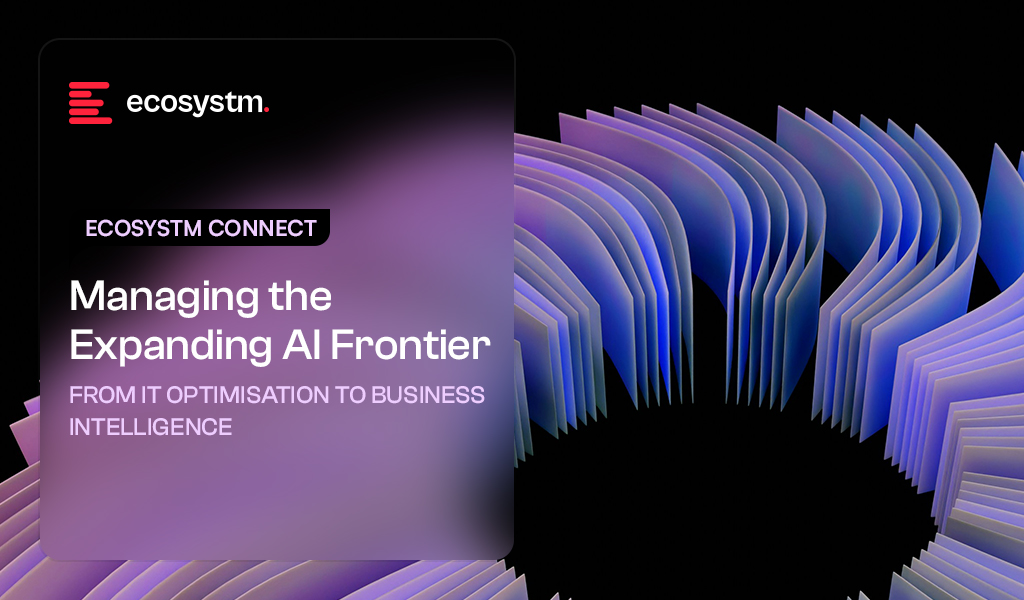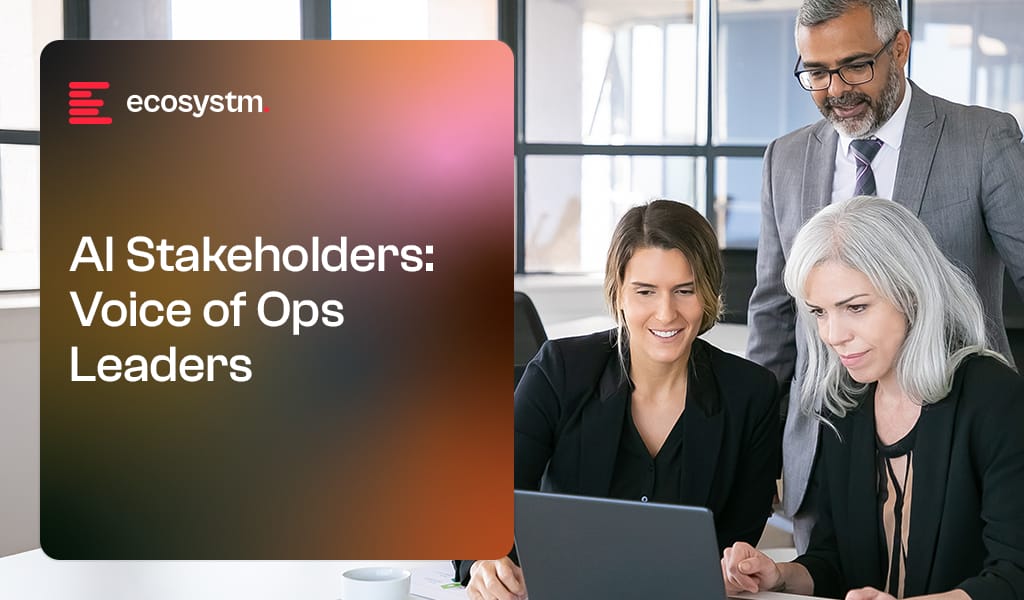AI adoption is no longer a question of if, but how fast and how well. Most organisations are exploring AI in some form, but they’re moving at very different speeds.

The ones seeing the most value share a few traits: cross-functional collaboration, strong leadership sponsorship, and tight alignment between business and tech. That’s how they sharpen focus, deploy critical skills where it matters, and accelerate from idea to outcome.
But the gap between ambition and execution is real. As one executive put it, “We’ve seen digital natives do in 24 hours what takes our industry six months.” The risks of getting it wrong are just as real; think of Zillow’s USD 500M loss from overreliance on flawed AI models.
When done right, AI benefits every part of the organisation; not just data teams.
“Our AI-powered screening for insurance agents fast-tracks candidate selection by analysing resumes and applications to pinpoint top talent.” – HR Leader
“Conversational AI delivers 24/7 customer engagement, instantly resolving queries, easing team workload, and boosting CX.” – CX Leader
“AI transforms work by streamlining workflows and optimising transport routes, making operations faster and smarter.” – Operations Leader
“Using AI to streamline our sales pipeline has cut down the time it takes to qualify leads, enabling our team to focus on closing more deals with greater precision.” – Sales Leader
“We’re unlocking data value: AI agents personalise customer support at scale, while AI-driven network optimisation ensures seamless IT operations.” – Data Science Leader
In the short term, most businesses are focusing on operational efficiency, but the real wins will be in longer-term innovation and financial value.

For tech teams, this means delivering robust, scalable AI systems while supporting responsible experimentation by business teams – all in a fast-moving, high-stakes environment.
However, that’s not easy.
• High Costs. AI requires substantial upfront and operational spend. Without measurable outcomes, it’s hard to justify scaling.
• Security & Governance Risks. AI heightens exposure to bias, misuse, and compliance gaps. Most organisations lack mature guardrails to manage this.
• Regulatory Uncertainty. Shifting global policies make it difficult to design AI systems that are both future-proof and compliant.
• Skills Shortage. There’s a growing gap in AI and data expertise. Without the right talent, even promising use cases falter.
• Data Challenges. AI needs vast, high-quality data, but many organisations struggle with silos, poor lineage, and inconsistent standards.
Yet the toughest obstacles aren’t technical.
• Limited AI Fluency at the Top. Many leaders lack a practical understanding of AI’s capabilities and constraints, slowing decisions and making cross-functional alignment difficult.
• No Clear Ownership or Strategy. Without clear ownership, AI efforts remain scattered across IT, innovation, and business teams, leading to fragmentation, misalignment, and stalled progress.
• Unclear ROI and Benefits. AI’s value isn’t always immediate or financial. Without clear metrics for success, it’s hard to prioritise initiatives or secure sustained investment.
• Short-Term Pressure. The push for quick wins and fast ROI often comes at the expense of long-term thinking and foundational investments in AI capabilities.
• Rigid Business Models. AI demands adaptability in processes, structures, and mindsets. But legacy workflows, technical debt, and organisational silos frequently stand in the way.
• Change Management is an Afterthought. Many AI efforts are tech-first, people-later. Without early engagement and capability building, adoption struggles to gain traction.
Bridging the Innovation-AI Gap: The Power of Ecosystems
Bridging this gap between AI ambitions and success requires more than technology; it needs a coordinated ecosystem of vendors, enterprises, startups, investors, and regulators working together to turn innovation into real-world impact.
Public-private partnerships are key. In Singapore, initiatives like IMDA’s Spark and Accreditation programmes tackle this head-on by spotting high-potential startups, rigorously validating solutions, and opening doors to enterprise and government procurement. This approach de-risks adoption and speeds impact.
• For Enterprises. It means quicker access to trusted, local solutions that meet strict performance and compliance standards.
• For Startups. It unlocks scale, credibility, and funding.
• For the Economy. It creates a future-ready digital ecosystem where innovation moves beyond the lab to drive national competitiveness and growth.

The Manufacturing sector, traditionally defined by stable processes and infrastructure, is now facing a pivotal shift. Rapid technological advancements and shifting global market dynamics have rendered incremental improvements inadequate for long-term competitiveness and growth. To thrive, manufacturers must fundamentally reimagine their entire value chain.
By embracing intelligent systems, enhancing agility, and proactively shaping future-ready operations, organisations can navigate today’s industrial complexities and position themselves for sustained success.

Here are recent examples of Manufacturing transformation in the Asia Pacific.
Click here to download “Future Forward: Reimagining Manufacturing” as a PDF.
Intelligent Automation & Efficiency
Komatsu Australia, a global industrial equipment manufacturer, tackled growing inefficiencies in its small parts department, where teams manually processed hundreds of PDF invoices daily from more than 250 suppliers.
To streamline this, the company deployed intelligent automation – AI now extracts and validates data from invoices against purchase orders and inputs it directly into the legacy mainframe.
The impact has been sharp: over 300 hours saved annually for one supplier, 1,100 invoices processed in three weeks, and a dramatic drop in manual errors. Employees have shifted to higher-value tasks, and a citizen developer program is enabling staff to build custom automation tools. With a scalable framework in place, Komatsu has not only transformed invoice processing but also set the stage for broader automation across the enterprise.
Data-Driven Insights & Agility
Berger Paints India Ltd., a leader in paints and coatings, needed to scale fast amid rising database loads and complex on-prem systems.
In response, Berger Paints migrated its mission-critical databases and core business applications – covering finance, manufacturing, sales, and asset management – to a high-performance cloud platform.
This shift boosted operational efficiency by 25%, doubled reporting and system response times, and enhanced scalability and disaster recovery with geographically distributed cloud regions. The move simplified access to data, driving faster, insight-driven decision-making. With streamlined infrastructure management and optimised costs, Berger Paints is now poised to leverage advanced technologies like AI/ML, setting the stage for continued innovation and growth.
Connected Operations & Customer Centricity
JSW Steel, one of India’s leading steel producers, set out to shift from a plant-centric model to a customer-first approach. The challenge: integrating complex systems like ERP, CRM, and manufacturing to streamline operations and improve order fulfillment.
With a robust integration platform, JSW Steel connected over 32 systems using 120+ APIs – automating processes and enabling real-time data flow across orders, inventory, pricing, and production.
The results speak for themselves: faster order fulfillment, reduced cost-to-serve, and real-time visibility that optimises scheduling. Scalable, composable APIs now support growth, while a 99.7% success rate across 7.2 million API calls ensures reliability. JSW Steel has transformed how it operates – running faster, serving smarter, and delivering better customer experiences across the entire order-to-cash journey.
Modernising Core Systems & Foundational Transformation
Fujitsu General, a global leader in air conditioning systems, was constrained by a 30-year-old COBOL-based mainframe and fragmented processes. The legacy system posed a Y2K-like risk and limited operational agility.
The company implemented a modern, unified ERP platform to eliminate risk, streamline operations, and boost agility.
By integrating functions across sales, production, procurement, accounting, and HR and addressing unique business needs with low-code development, the company created a clean, adaptable core system. Robust integration connected disparate data sources, while a central repository eliminated silos. The transformation delivered seamless end-to-end operations, standardised workflows, improved agility, and real-time insights – setting Fujitsu General up for continued innovation and long-term resilience.
Powering Growth with a Modern Network
As a critical supplier to India’s infrastructure boom, Hindalco needed to modernise its network across 55 sites – improving app performance, enabling real-time insights, and building a future-ready, sustainable foundation.
Hindalco replaced its ageing hub-and-spoke model with a modern mesh architecture using SD-WAN.
The new architecture prioritised key app traffic, simplified cloud access, and enabled segmentation. Centralised orchestration and SSE integration brought automation and robust security. The impact: 30% lower costs, 50% faster apps, real-time visibility, rapid deployment, and smarter bandwidth. Hindalco now runs on a lean, secure digital backbone – built for agility, performance, and scale.

Ecosystm research finds that 54% of organisations place cost savings as the key focus of AI adoption. This explains why Operations shapes AI and use cases.
But the teams often lack control over data and solutions.
Overcoming these gaps will be crucial for stronger execution and long-term success.
Here’s where Operations leaders stand today.

Operations leaders are on the front lines of the AI revolution. They see the transformative potential of AI and are actively driving its adoption to streamline processes, boost efficiency, and unlock new levels of performance. The value is clear: AI is no longer a futuristic concept, but a present-day necessity.
Over the past two years, Ecosystm’s research – including surveys and deep dives with business and tech leaders has confirmed this: AI is the dominant theme.
Here are some insights for Operations Leaders from our research.
Click here to download “AI Stakeholders: The Operations Perspective” as a PDF
From Streamlined Workflows to Smarter Decisions
AI is already making a tangible difference in operations. A significant 60% of operations leaders are currently leveraging AI for intelligent document processing, freeing up valuable time and resources. But this is just the beginning. The vision extends far beyond, with plans to expand AI’s reach into crucial areas like workflow analysis, fraud detection, and streamlining risk and compliance processes. Imagine AI optimising transportation routes in real-time, predicting equipment maintenance needs before they arise, or automating complex scheduling tasks. This is the operational reality AI is creating.
Real-World Impact, Real-World Examples
The impact of AI is not just theoretical. Operations leaders are witnessing firsthand how AI is driving tangible improvements. “With AI-powered vision and sensors, we’ve boosted efficiency, accuracy, and safety in our manufacturing processes,” shares one leader. Others highlight the security benefits: “From fraud detection to claims processing, AI is safeguarding our transactions and improving trust in our services.” Even complex logistical challenges are being conquered: “Our AI-driven logistics solution has cut costs, saved time, and turned complex operations into seamless processes.” These real-world examples showcase the power of AI to deliver concrete results across diverse operational functions.
Operations Takes a Seat at the AI Strategy Table (But Faces Challenges)
With 54% of organisations prioritising cost savings from AI, operations leaders are rightfully taking a seat at the AI strategy table, shaping use cases and driving adoption. A remarkable 56% of operations leaders are actively involved in defining high-value AI applications. However, a disconnect exists. Despite their influence on AI strategy, only a small fraction (7%) of operations leaders have direct data governance responsibilities. This lack of control over the very fuel that powers AI – data – creates a significant hurdle.
Further challenges include data access across siloed systems, limiting the ability to gain a holistic view, difficulty in identifying and prioritising the most impactful AI use cases, and persistent skills shortages. These barriers, while significant, are not deterring operations leaders.
The Future is AI-Driven
Despite these challenges, operations leaders are doubling down on AI. A striking 7 out of 10 plan to prioritise AI investments in 2025, driven by the pursuit of greater cost savings. And the biggest data effort on the horizon? Identifying and prioritising better use cases for AI. This focus on practical applications demonstrates a clear understanding: the future of operations is inextricably linked to the power of AI. By addressing the challenges they face and focusing on strategic implementation, operations leaders are poised to unlock the full potential of AI and transform their organisations.

































